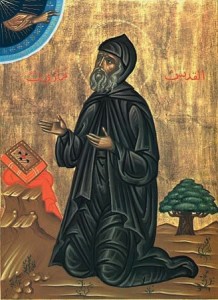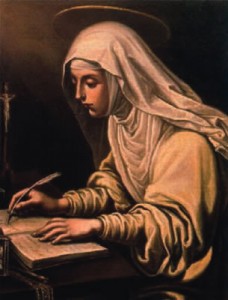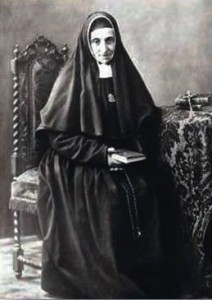February Saints
 Saint Maro (d. c. 435)
Saint Maro (d. c. 435)
St. Maro chose a solitary abode near Cyrrhus in Syria, and there, in a spirit of mortification, he lived mainly in the open air. He had a little hut covered with goatskins to shelter him in case of need, but he seldom made use of it. Finding the ruins of the heathen temple, he dedicated it to the true God, and made it his house of prayer.
Maro was a disciple of St. Zebinus. Drawing great crowds by his spiritual wisdom, he trained many hermits and monks and founded three monasteries. It is believed the Maronites take their name from Bait-Marun monastery, where a church was erected over his tomb. Saint Maro, help us to live true to our Catholic faith.
(Encyclopedia of the Saints, Matthew, Margaret & Stephen Bunson, 1998, Our Sunday Visitor Publishing, Indiana)
 Saint Catherine of Ricci
Saint Catherine of Ricci
(1522-1589)
St. Catherine was born in Florence. Her baptismal name was Alexandrina, but she took the name of Catherine upon entering religion. From her earliest infancy she manifested a great love of prayer, and in her sixth year, her father placed her in the convent of Monticelli in Florence, where her aunt, Louisa de Ricci, was a nun.
After a brief return home, she entered the convent of the Dominican nuns at Prat in Tuscany, in her fourteenth year. While very young, she was chosen Mistress of Novices, then subprioress, and at twenty-five years of age she became perpetual prioress.
The reputation of her sanctity drew to her side many illustrious people, among whom three later sat in the chair of Peter, namely Cerveni, Alexander de Medici, and Aldo Brandini, and afterward Marcellus II, Clement VIII, and Leo XI respectively. She corresponded with St. Philip Neri and, while still living, she appeared to him in Rome in a miraculous manner.
She is famous for the “Ecstasy of the Passion” which she experienced every Thursday from noon until Friday at 4:00 p.m. for twelve years. After a long illness she died in 1589.
Saint Catherine, obtain for us a great love of prayer.
(http://www.catholic.org/saints/saint.php?saint_id=587)
 Saint Paula Montal Fornés (1799-1889)
Saint Paula Montal Fornés (1799-1889)
Paula Montal Fornés was born in Spain, a country troubled by a struggle to cast off an old regime and bring in a new one. The eldest of five children, she grew up in Barcelona. The family was modest and deeply Christian. The young girl participated in the spiritual life of her parish and stood out because of her devotion to the Virgin Mary. When her father died, Paula, aged 10, had to work as a seamstress and lacemaker to help support the family. From personal experience, she came to realise how few educational possibilities there were for women and became consumed by a desire to address that need.
At age 30, still single and devoting herself privately to God, she and her friend Inez Busquets opened a school in Gerona to provide a good education for girls. Her goal was to provide a complete human Christian education for girls and young women and, by thus advancing women, to save families and transform society. The breadth of these educational programmes far surpassed that provided for boys of her time. The school was such a success that she was able to found further schools in 1842 and 1846.
To staff and manage the schools, Paula founded the Daughters of Mary (Pious School Sisters) in the spirit of St Joseph of Calasanz, to whom she was particularly devoted. With the help of two Piarist Fathers, she was able to establish the Congregation relatively quickly. At the first General Chapter meeting in 1847, she was not elected Superior General or even Assistant General but she became very busy founding schools and training the first 130 Sisters of the Congregation. Her followers would distinguish themselves by professing a fourth vow of teaching.
The last school she founded was in Olesa de Montserrat, a poor little town where Paula stayed for the last 30 years of her life. Here her generous and holy life inspired all those with whom she came in contact. For her Congregation and for the girls and women of the town, she modelled a total ‘yes’ to God in the spirit of her patron. Her particular holiness had two facets: her participation in the Calasanz spirituality, and her unique educational charisma in the service of women. She died on 26 February 1889.
Saint Paula, teach us to be good role models for our young people.
(Source: Internet – various)
 Entries(RSS)
Entries(RSS)